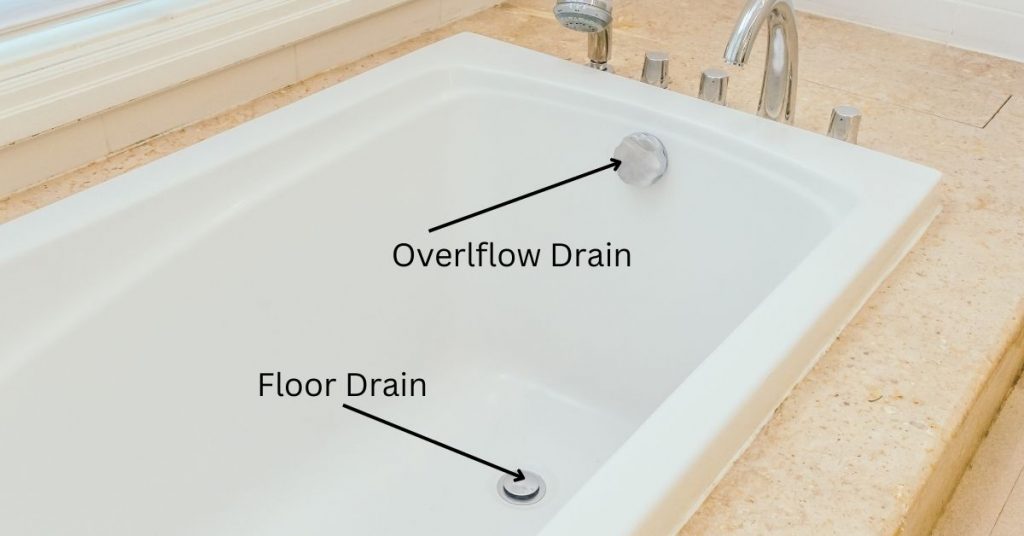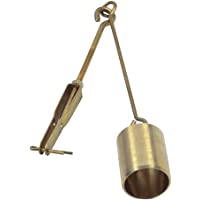
A bathtub overflow drain is a crucial component of a bathtub plumbing system. It serves as a secondary drainage point to prevent overflowing if the primary drain gets blocked or if the water level in the tub rises too high during use.
Here’s how a bathtub overflow drain works:
- Position: The overflow drain is typically located near the top of the bathtub, often underneath or behind the faucet.
- Design: It consists of a drain opening covered by an overflow cover plate. Behind the cover plate is a gasket that creates a watertight seal when the cover is in place.
- Function: When you fill the bathtub, water enters both the main drain at the bottom of the tub and the overflow drain near the top. As long as water flows freely down the main drain, the overflow drain remains dry.
- Safety Feature: If the water level in the tub rises to the point where it covers the overflow drain opening, the excess water enters the overflow drain and flows down a pipe connected to the main drain line. This prevents the tub from overflowing onto the bathroom floor.
Bathtub Overflow Drain Diagram

If you want to stop your bathtub overflow from draining (to have more water in the tub), seal the overflow drain opening using a bathtub overflow cover, plumber’s tape or duct tape. For a permanent solution consider installing an adjustable overflow plate.
So, are bathtub overflow drains required? Like must a bathtub have a bathtub overflow drain?
A bathtub overflow drain is not a requirement. It is however important to make sure that you have a mechanism in place to prevent flooding in the bathroom. Having a floor drain is one such way but be sure to first check your local plumbing codes.
A bathtub drain overflow can leak, which is manifested by a leaking or stained ceiling of the floor below. The leak is usually caused by a worn our seal/gasket which you can easily replace on your own.
How Bathtub Overflow Drain Works
It is almost impossible to talk about a bathtub overflow drains without mentioning tub stoppers. A tub stopper is the mechanism which allows you to plug the drain and fill the tub with water.
There are 2 types of tub stoppers. These are pop-up bathtub stoppers and trip-lever bathtub stoppers.
Pop-up bathtub stoppers are found at the bottom of the tub screwed on the tub’s main drain. On the other hand, trip-lever tub stoppers are installed inside the overflow drain.
Trip-lever stoppers are what you will see in most alcove bathtubs (bathtubs installed in an alcove/3 wall of the bathroom. You can also convert a trip level stopper into a pop-up stopper as shown in this post.
What you will see mounted on the drain overflow cover plate is the trip mechanism. However, inside the vertical section of the overflow drain is an adjustable link chain which is connected to a plunger.

The plunger is what seals the drain when you want to fill the tub. To plug the drain you simply push the trip lever up and to drain the tub you pull it down.
As I have already mentioned, the overflow drain and the tub’s main drain share the same drain line. To accomplish that, a tee (T-fitting) is used to connect both the overflow drain and the tub’s floor drain.
Apart from draining excess water from the tub, the overflow drain also plays a vital role when unclogging a bathtub. How is that the case?
As you can see from above diagram, the overflow drain pipe is straight while the pipe from the floor drains takes a few turns. It therefore makes more sense to snake the drain line through the overflow drain, unless the clog is just below the floor drain opening.
Whenever you are dealing with a clogged bathtub, the clog in most cases is usually the U-shaped part of the drain line called a P-trap. Accessing the P-trap through the overflow drain is quite easy and also makes the process very effective.
Can a Bathtub Still Overflow even with An Overflow Drain?
The truth of the matter is that tub overflow drains are not foolproof. That means it is still very possible for your bathtub to overflow despite having an overflow drain.
But how is that possible in the first place?
Remember what I said about the bathtub floor drain and overflow drain sharing the same drain line. That is usually the problem.
If you have a clog in the drain line (passed the tee), it will affect both the bathtub floor drain and the overflow drain.
A clogged bathtub drain line is indicated by standing water in the bathtub or a slow draining bathtub. A slow draining bathtub can however also be caused by a clogged plumbing vent, but that problem will be manifested in other drains as well.
If you have a clogged tub drain line and then your tubs fills up to the overflow drain and water starts to drain out, the overflow drain line will quickly fill with water and the excess water will overflow through the rim of the tub.
There are 2 types of bathtub drain overflows. These are the traditional and integral overflows. The traditional overflow is also known as a conventional overflow.
In a traditional tub overflow drain, a hole is made on the side of the tub and a vertical pipe is connected to it, which drains to the tub’s drain line. This type of overflow drain is quite conspicuous and common in old bathrooms.
With an integral tub overflow drain, the overflow is integrated into the body of the tub, like a sink’s overflow drain. An opening is made inside the tub’s walls which makes it less conspicuous.
How Do I Stop My Bathtub Overflow from Draining
If you are a tall person or you would just like more water in the tub, an overflow drain surely will be in your way of accomplishing that.
There are a few ways of stopping a bathtub overflow drain from draining water out of the bathtub. Just know that you need to be very careful to prevent an overflow.
As you fill the tub, you will also need to account for your own body volume. If you remember any physics, your body is going to replace water of an equivalent volume from the tub.
If you fill the tub to the brim and hop inside, water of volume similar to your body’s will overflow to the floor of the bathroom.
With that in mind, these are some of the ways to stop or seal a bathroom overflow drain and stop it from draining.
1. Use an Overflow Cover
Bathtub drains overflow covers are cheap, easy to put on and reusable. You can get these covers for under $10 on Amazon or any other online or physical store.
The covers which look like cups use suction force to seal around the tub’s overflow drain opening. All you will need to do is insert the cup in water and then push it over the overflow drain to seal.
Once you are done soaking in the tub, simply pry off the cover and place it away ready for use the next time you are using the bathtub.
2. Install an Adjust Overflow Plate
If you are looking for a permanent solution, an adjustable overflow plate is the way to go. Depending on your preference and budget, these plates are made from different materials like chrome, brushed nickel, oil-rubbed bronze, polished brass etc.
How this plate works is that it has another inner plate which contains the overflow drain. The otter plate can be turned to open or close the overflow drain.
You may think that installing the plate is hard but it is quite easy. You only need a screwdriver and a few minutes of time.
If you want an instant solution without dashing to the store, you can roll a bead of plumber’s putty and use it to seal the overflow drain opening. Duct tape is another worthwhile product to use.
Are Bathtubs Overflow Drains Required
So, does a bathtub have to have an overflow drain? Well, actually not. You can opt not to install an overflow drain although you should first check with local plumbing and also have a secondary plan to prevent flooding.
Bathtubs like freestanding bathtubs or Japanese/soaking tubs look so elegant but overflow drains tend to take beauty away from them. This is not a fact but it is only true for some people.
In such a case, you may resolve to do away with overflow drains. You will have to be careful however to prevent overflows and ruin your floor or valuables.
What you can do instead is to install a floor drain. That way, you will be assured that in case of an overflow the excess water will be channeled out into the drainage system
How to Fix a Leaking Bathtub Drain Overflow
If your bathtub is leaking through the ceiling of the floor below especially only when someone is soaking in the bathtub, a worn overflow drain gasket is usually the problem.
Luckily, removing the old gasket and installing a new is pretty easy. You will only need a screw driver to remove the overflow plate and to install it back.
Here is a video from YouTube to help you do exactly that.








